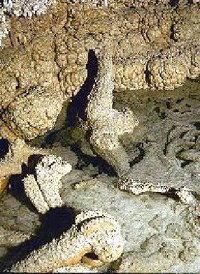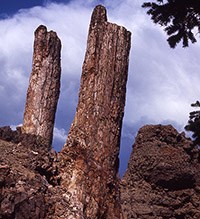Last updated: April 22, 2020
Article
NPS-Smithsonian Collaboration Promotes Public and Scientific Access to Important Fossils
Paleontologists and staff from both the National Park Service (NPS) and the Smithsonian’s National Museum of Natural History (USNM) have been quietly working together on a project that will be available to the public as part of the 2018 National Fossil Day celebration. On October 17, 2018, the Smithsonian will premiered a website of interactive 3-D computer models produced by the National Park Service and hosted by Digitization Program Office featuring important fossils collected from several NPS areas and which are maintained in the collections of the USNM. This project will enable the public, researchers, and NPS staff to access rare and important fossil specimens from parks which are not currently on display and readily available for public viewing.
These models were created through the use of a technique called Structure-from-Motion or digital photogrammetry. Photogrammetry as a method, has been used since shortly after the invention of photography. It is in a sense, using photographs of an object to make accurate measurements by shifting camera positions known distances. The modern technique takes advantage of advances in digital cameras, powerful consumer-level computer hardware and software, to “virtually” reconstruct an object. The digital 3-dimensional model is made via the software by finding 1000s of points in common on the object surface from a group of overlapping images. Combined with scaling (e.g., objects of known length) in the image groups, highly accurate and precise digital renderings can be generated. Once created, these 3D models can be shared remotely on the web, emailed and even printed with 3D printing technology.
These models were created through the use of a technique called Structure-from-Motion or digital photogrammetry. Photogrammetry as a method, has been used since shortly after the invention of photography. It is in a sense, using photographs of an object to make accurate measurements by shifting camera positions known distances. The modern technique takes advantage of advances in digital cameras, powerful consumer-level computer hardware and software, to “virtually” reconstruct an object. The digital 3-dimensional model is made via the software by finding 1000s of points in common on the object surface from a group of overlapping images. Combined with scaling (e.g., objects of known length) in the image groups, highly accurate and precise digital renderings can be generated. Once created, these 3D models can be shared remotely on the web, emailed and even printed with 3D printing technology.

Ron Kerbo


NPS
According to the NPS Senior Paleontologist, Vincent L. Santucci, “The NPS and the Smithsonian’s USNM have a long relationship and history of collaboration involving paleontology and fossils. Together the NPS preserves the places where the fossils are collected and the Smithsonian preserves the actual fossil specimens for the public to learn about and scientists to study.” To see these fossils and to learn about others, visit the Smithsonian’s digital archive. To see how the NPS is utilizing digital photogrammetry for improving our understanding of park geologic and paleontologic resources, visit our Geohazards site.
